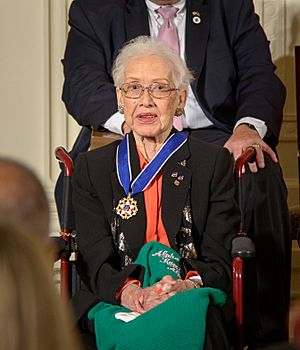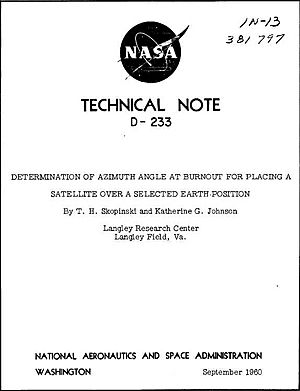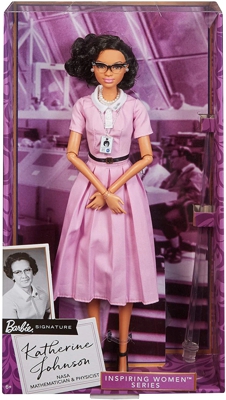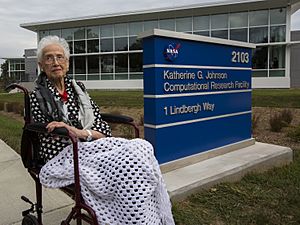Katherine Johnson facts for kids
Quick facts for kids
Katherine Johnson
|
|
|---|---|

Johnson in 1983
|
|
| Born |
Katherine Coleman
August 26, 1918 |
| Died | February 24, 2020 (aged 101) Newport News, Virginia, U.S.
|
| Other names | Katherine Goble |
| Alma mater | West Virginia State College |
| Occupation | Mathematician |
| Employer | NACA, NASA 1953–1986 |
| Known for | Calculating trajectories for NASA missions |
| Spouse(s) |
|
| Children | 3 |
| Awards |
|
Katherine Johnson (born Coleman; August 26, 1918 – February 24, 2020) was an amazing American mathematician. She worked for NASA and her math skills were super important for the first U.S. spaceflights with astronauts. She figured out how spacecraft would move in space.
During her 33 years at NASA and its earlier agency, she became known for being great at doing complicated math by hand. She also helped start using computers for these tasks. NASA said she was one of the first African-American women to be a scientist there.
Katherine Johnson's work included calculating the paths for spacecraft. She also figured out the best times for rockets to launch. Her calculations helped astronauts return safely if there was an emergency. She worked on flights for Alan Shepard, the first American in space, and John Glenn, the first American to orbit Earth. She also helped with the Apollo program missions to the Moon. Her math was key for the start of the Space Shuttle program too. She even worked on plans for a mission to Mars. People called her a "human computer" because she was so good at math, even with very little technology back then.
In 2015, President Barack Obama gave Johnson the Presidential Medal of Freedom. This is a very high award in the U.S. In 2016, she received the Silver Snoopy award and a NASA Group Achievement Award. She was played by Taraji P. Henson in the 2016 movie Hidden Figures. In 2019, she received the Congressional Gold Medal from the United States Congress. In 2021, she was added to the National Women's Hall of Fame.
Contents
Early Life and Education
Katherine Johnson was born Creola Katherine Coleman on August 26, 1918. She grew up in White Sulphur Springs, West Virginia. She was the youngest of four children. Her mom was a teacher and her dad worked many jobs, including at a hotel.
Katherine was very good at math from a young age. In her county, African-American students could not go to public high school after eighth grade. So, her family arranged for her to go to high school in Institute, West Virginia. This school was on the campus of West Virginia State College (WVSC). Katherine started high school when she was only ten years old! Her family would live in Institute during the school year and go back home in the summer.
She finished high school at age 14. Then she went to WVSC, which was a college mainly for black students. She took every math class they offered. Some professors, like Angie Turner King and William Schieffelin Claytor, helped her a lot. Claytor even created new math courses just for her. She graduated in 1937, at age 18, with degrees in math and French. She was one of the best students in her class. After college, she became a teacher in Virginia.
In 1939, she married James Goble and stopped teaching to go to graduate school for math. She was the first African-American woman to attend graduate school at West Virginia University. She left after a year to focus on her family when she became pregnant.
Working as a "Human Computer"
Katherine Johnson wanted to be a research mathematician. But it was hard for African Americans and women to get jobs in that field back then. She first worked as a teacher. In 1952, a family member told her that the National Advisory Committee for Aeronautics (NACA) was hiring mathematicians. NACA was located in Hampton, Virginia. They hired both black and white mathematicians. Johnson got a job offer in June 1953.
At first, Katherine worked with a group of women who did math calculations. She called them "computers who wore skirts." Their main job was to read data from airplane "black boxes" and do other exact math problems. One day, Katherine and a friend were asked to help the all-male flight research team. Katherine was so good at analytic geometry (a type of math) that the male bosses and co-workers wanted her to stay. She said, "they forgot to return me to the pool."
Even though there were racial and gender barriers, Katherine said she ignored them. She was brave and asked to be in important meetings where no women had been before. She simply told people she had done the work and belonged there.
From 1953 to 1958, Johnson worked as a "computer." She analyzed things like how to make aircraft flights smoother. She was first in the West Area Computers section, led by Dorothy Vaughan. Later, she moved to the Guidance and Control Division. Because of state laws and rules from that time, Johnson and other African-American women had separate offices, bathrooms, and eating areas from white co-workers. Their office was called "Colored Computers." But Johnson said she "didn't feel the segregation at NASA, because everybody there was doing research." She added, "You had a mission and you worked on it, and it was important to you to do your job."
NASA and Space Missions
In 1958, NACA became NASA, and they started using digital computers. The offices became desegregated, meaning black and white employees could work together. But some unfair treatment still happened. Katherine remembered:
"We needed to be assertive as women in those days... In the early days of NASA, women were not allowed to put their names on reports." She was working with a man named Ted Skopinski. He told their supervisor that Katherine should finish a report because she had done most of the work. So, Katherine finished it, and her name was on it. This was the first time a woman in her division had her name on a report.
From 1958 until she retired in 1986, Johnson worked as an aerospace technologist. She calculated the path for Alan Shepard's space flight on May 5, 1961. He was the first American in space. She also figured out the best time for his rocket to launch. She made backup navigation charts for astronauts in case their electronic systems failed.
When NASA used electronic computers for the first time to calculate John Glenn's orbit around Earth, officials asked Johnson to check the computer's numbers. Glenn himself asked for her specifically! He refused to fly unless Katherine verified the calculations. This was because her calculations were much harder, as they had to consider the pull of planets and stars. Author Margot Lee Shetterly said, "the astronaut who became a hero, looked to this black woman in the still-segregated South... as one of the key parts of making sure his mission would be a success."
Katherine Johnson also worked directly with digital computers. Her amazing skills and reputation for being accurate helped people trust the new computer technology. In 1961, her work helped make sure Alan Shepard's Freedom 7 capsule was found quickly after it landed.
She also helped calculate the path for the 1969 Apollo 11 flight to the Moon. During the Moon landing, Johnson was at a meeting. She and others watched the first steps on the Moon on a small TV screen. In 1970, Johnson worked on the Apollo 13 Moon mission. When that mission had problems, her work on backup plans helped the crew return safely to Earth. She created a special system that let astronauts find their location accurately. Katherine remembered, "Everybody was concerned about them getting there. We were concerned about them getting back."
Later in her career, Johnson worked on the Space Shuttle program. She also worked on the Earth Resources Satellite and plans for a mission to Mars.
After retiring, Katherine Johnson spent her time encouraging young people to study science, technology, engineering, and mathematics (STEM).
Personal Life
Katherine and her first husband, James Francis Goble, had three daughters. The family lived in Newport News, Virginia. James died in 1956. Three years later, Katherine married James A. "Jim" Johnson. They were married for 60 years until he passed away in 2019. Katherine had six grandchildren and 11 great-grandchildren. She lived in Hampton, Virginia. She always encouraged her grandchildren and other students to go into science and technology.
She was a member of Carver Memorial Presbyterian Church for 50 years and sang in the choir. She was also part of the Alpha Kappa Alpha Sorority.
Katherine Johnson passed away on February 24, 2020, at 101 years old. NASA's administrator, Jim Bridenstine, called her "an American hero." He said her "pioneering legacy will never be forgotten."
Katherine Johnson Quotes
- "Like what you do, and then you will do your best."
- "Girls are capable of doing everything men are capable of doing. Sometimes they have more imagination than men."
- "I don't have a feeling of inferiority. Never had. I'm as good as anybody, but no better."
- "Take all the courses in your curriculum. Do the research. Ask questions. Find someone doing what you are interested in! Be curious!"
- "I was excited at something new, always liked something new, but give credit to everybody who helped. I didn't do anything alone but try to go to the root of the question and succeeded there."
- "I like to learn. That's an art and a science."
- "I was just excited to have challenging work to do and smart people to work with."
Interesting Facts and Honors

- Katherine Johnson helped write 26 scientific papers.
- She is seen as a great example of African-American women in STEM.
- Two NASA buildings have been named after her. In 2016, a new building at NASA's Langley Research Center was named the "Katherine G. Johnson Computational Research Facility."
- In 2019, NASA also renamed another facility in West Virginia to the Katherine Johnson Independent Verification and Validation Facility.
- Many other schools and buildings have been named in her honor, including at George Mason University and several middle schools.
- In 2016, the BBC included her on their list of 100 Women who influenced the world.
- A Lego set for Women of NASA was created in 2016 and included Johnson.
- Mattel released a Barbie doll that looks like Katherine Johnson in 2018.
- In 2020, a satellite named "Katherine" was launched into space.
- In 2021, a spacecraft that supplies the International Space Station was named the SS Katherine Johnson in her honor.
- In 1999, she was named West Virginia State College Outstanding Alumnus of the Year.
- President Barack Obama gave her the Presidential Medal of Freedom on November 24, 2015.
- In 2017, Johnson received a Silver Snoopy award. This award is often called the astronaut's award. NASA gives it to people who make great contributions to flight safety and mission success.
- In 2018, she received an honorary doctorate from the College of William & Mary.
- In 2018, West Virginia State University started a STEM scholarship in her honor and put up a statue of her.
- In 2019, she was added to the Government Hall of Fame.
- On November 8, 2019, she received the Congressional Gold Medal.
In Movies and TV
The popular movie Hidden Figures came out in 2016. It was based on a book about Katherine Johnson and other African-American women mathematicians who worked at NASA. Taraji P. Henson played Katherine Johnson in the movie. Katherine Johnson herself appeared with Taraji P. Henson at the 89th Academy Awards and received a standing ovation. Katherine said the movie was "well done" and that the actresses did a great job playing them.
In a 2016 episode of the TV show Timeless, Katherine Johnson was played by Nadine Ellis.
Awards and Recognition
- 1971, 1980, 1984, 1985, 1986: NASA Langley Research Center Special Achievement award
- 1977: NASA Group Achievement Award for her work on the Lunar Spacecraft and Operations team. This was for her important work in navigation for the spacecraft that mapped the Moon before the Apollo program.
- 1998: Honorary Doctor of Laws from SUNY Farmingdale.
- 1999: West Virginia State College Outstanding Alumnus of the Year.
- 2006: Honorary Doctor of Science by the Capitol College.
- 2010: Honorary Doctorate of Science from Old Dominion University.
- 2014: De Pizan Honor from National Women's History Museum.
- 2015: NCWIT Pioneer in Tech Award.
- 2015: Presidential Medal of Freedom.
- 2016: Silver Snoopy award from Leland Melvin.
- 2016: Astronomical Society of the Pacific's Arthur B.C. Walker II Award.
- 2016: Presidential Honorary Doctorate of Humane Letters from West Virginia University.
- December 1, 2016: Received the Langley West Computing Unit NASA Group Achievement Award. Her colleagues, Dorothy Vaughan and Mary Jackson, also received this award.
- 2017: Daughters of the American Revolution (DAR) Medal of Honor.
- 2017: Honorary Doctorate from Spelman College.
- May 12, 2018: Honorary Doctorate of Science from the College of William & Mary.
- April 29, 2019: The University of Johannesburg gave her an honorary doctorate for her important role at NASA.
- November 8, 2019: Congressional Gold Medal.
- 2021: Induction into the National Women's Hall of Fame.
See also
 In Spanish: Katherine Johnson para niños
In Spanish: Katherine Johnson para niños
- Annie Easley, mathematician
- List of African-American women in STEM fields







